Presenting on brands and museums at Museum Forward* in Jakarta, Indonesia, I found myself in a position I’ve rarely had the opportunity to experience—being a fish that was way out of my cultural waters and yet having the responsibility to take professional action.
I did not finalize my plan, loose as it was, until just a few minutes before I got up on stage on day 2 of the conference. The pressure had been building in me to do something. It was only my third day in Indonesia. I asked Nin Djani—a Jakarta based curator who was the moderator of our group of presenters—if what I was thinking of doing would be in any way culturally offensive. She said, “No, just informal.”
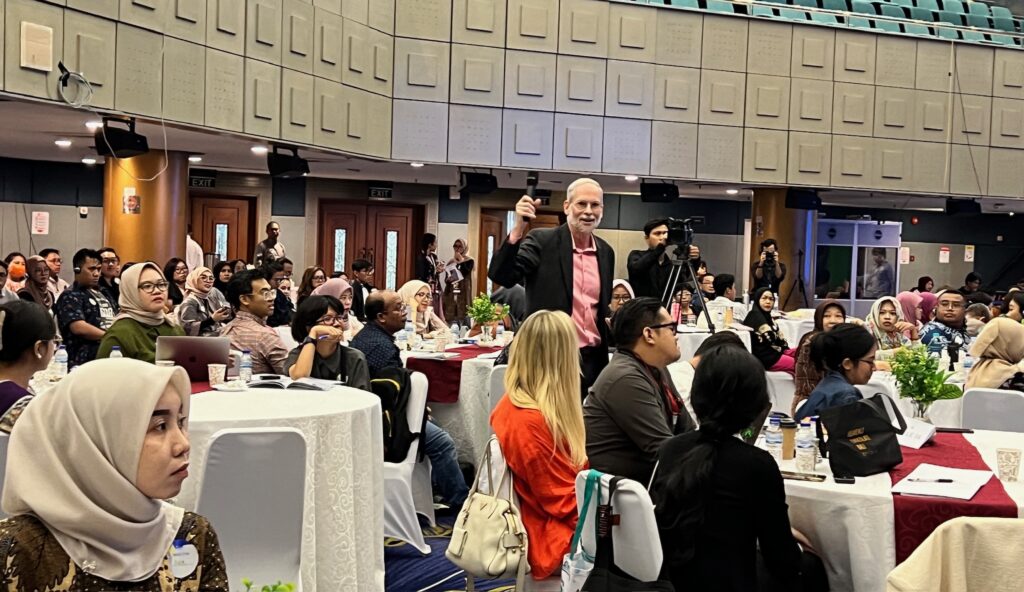
For 33 years, I have done my professional work almost entirely in the continental U.S. and Canada (with a few forays into the near outside with projects in Hawai‘i, Mexico, and Bermuda). I rarely experience the responsibility to represent an “American viewpoint” because I’m either downplaying it, as in Mexico or Hawai‘i (or even Canada), or more commonly swimming blithely along entirely unconscious of my own cultural context because it just is.
“Culture—no matter how defined—is singularly persistent.”
–Peter F. Drucker
The room was an enormous government conference space with a sofa, chairs, and bottled water on an elevated stage for the presenters. Behind the stage was a massive projection screen. Flanking the screen on either side were large photos of Indonesian dignitaries of inestimable public esteem. Each presenter followed a set formalized and protective pattern. They were given a formal introduction, packed with credentials and accomplishments, and then they walked over and stood behind the podium to read or deliver their presentations accompanied by slides with varying degrees of detail. This pattern repeated itself for nine hours on the first day with no pause.
It continued throughout the morning of the second day. By then, however, most of the dignitaries had cleared out, and the audience now was made up of dedicated and eager museum professionals, many of them young and at the outset of their careers. They had come, I suspect, to learn and to share ideas for best practice and to situate Indonesia within the larger world of museum practice. I respect their passion in the face of profound challenges in a developing country with a diverse geography of more than 17,000 islands, 700 living languages, and some 400 museums, most of which are not able to open their doors to the public for lack of curators or funds as they seek to serve a still mostly youthful 280 million national population.
What can we do here?
Indonesia is an immense and profoundly complicated place with a colonial history that still reverberates. As I watched the presentations, part of me felt increasingly uneasy. The young professionals who had come to the conference were perhaps getting what they came for, the opportunity to hear what some of the world’s foremost museums and cultural heritage sites were doing.
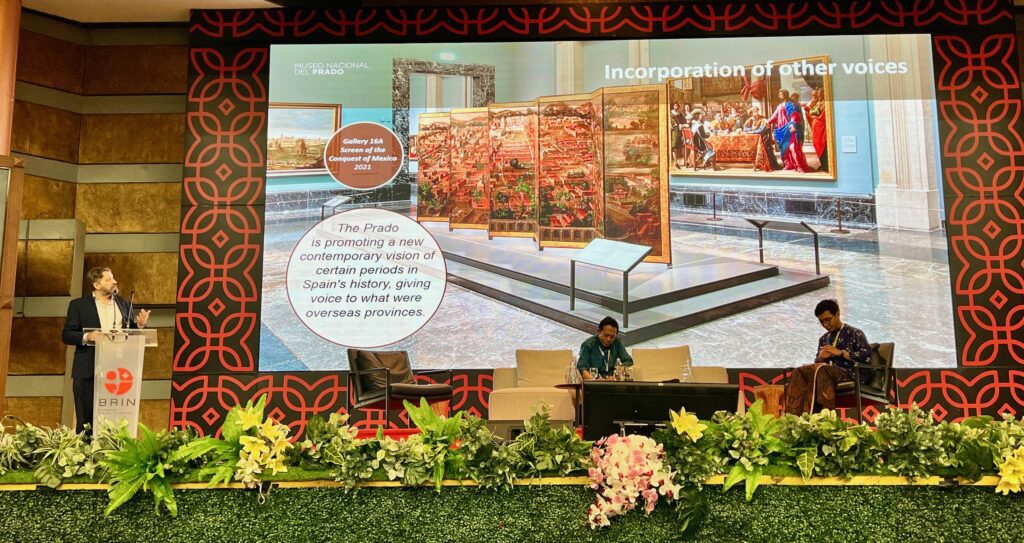
Victor Cageao from Museo del Prado gave an amazing presentation detailing the many practical innovations they have undertaken to make the collection more relevant to the visiting public. This was certainly a useful lens to understand best practice.
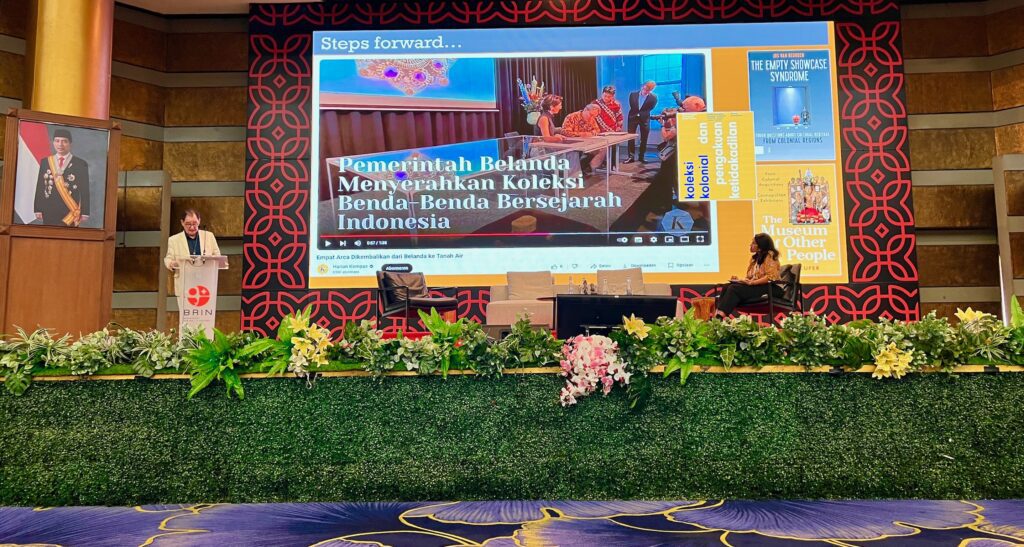
Max Meijer provided a window into how Indonesian cultural artifacts are presented and valued in the Netherlands and as the former colonial power in Indonesia, he bravely took on some of the big questions around decolonization and repatriation.
Hilmar Farid, Director General of Culture in the Indonesian government, opened the conference with a profound reminder of Drucker’s point, but in this case applied to the lingering legacy of colonialism. He highlighted the example of the National Museum of Indonesia, which just reopened this year after an electrical fire, pointing out the urgent need to reimagine museums in ways that break free from the inherited habits of colonialism, among them a long history of collecting and displaying art from the non-Western world in ways that are devoid of context and lack an appreciation of their meaning. The colonial treatment of art as a “cabinet of curiosities” is here shown as having been inherited and perpetuated by the colonized. It takes great effort to redirect or undo this kind of built in historical propensity. And it took a major fire to trigger the process of reimagining as the National Museum was rebuilt.
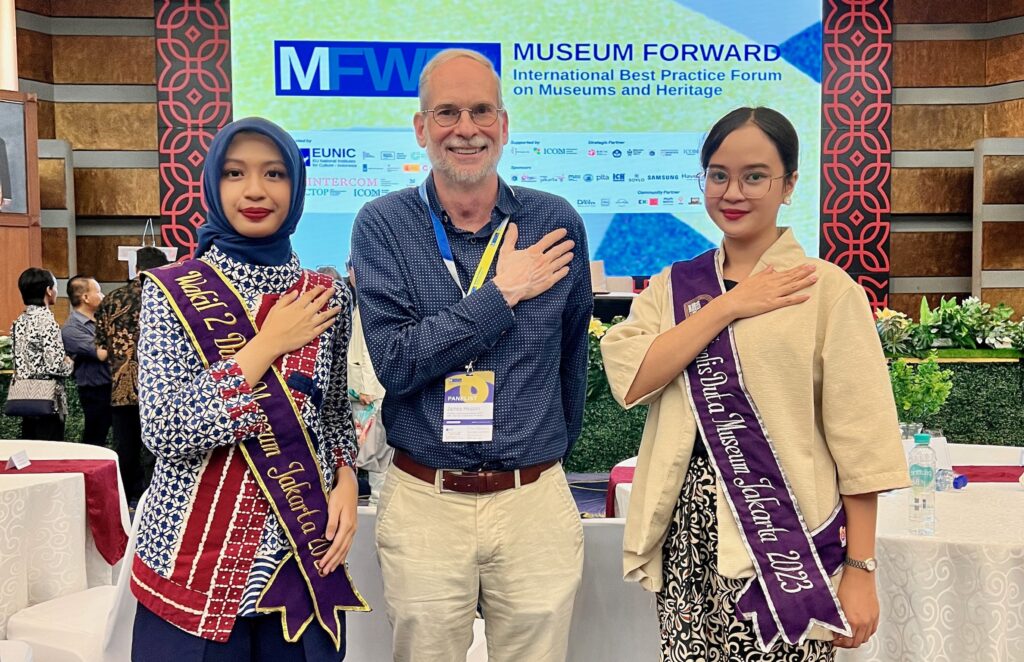
What can I do? I’m not a museum director or curator. I’m not even technically a museum professional. I’m a brand strategist giving a presentation on museum brands and the public. What brand idea were museums projecting through this rather rigid format for presentations?
It was primarily one of rigor and academic curiosity (laudable) and not one of inclusion or an expression of interest in what the audience might need or have to contribute. Perhaps this is unavoidable in a conference setting where experts fly in, deliver their wisdom, and fly out again. But the local museum professionals have to go back to their individual realities the next day. Do they walk back into the whirlwind and forget? Add to this challenge, the not so subtle overlay of colonial history in this particular place.
I felt I was being nudged by this setting to confront my own complicity in colonial history. What was the Tronvig or Heaton family role in all this? Was I potentially making things worse by being here?
The gulf between the presenters and the audience was palpable. I felt a responsibility to do something meaningful for the young professionals in the audience if I could. Hundreds of had gathered in this massive government conference hall to be inspired and to learn. What could I add to the mass of advice being downloaded from contexts in some cases far removed from their day-to-day reality? For example, however amazing on its face, how relatable are stories of a $1-billion museum to the situation of the young professionals gathered here?
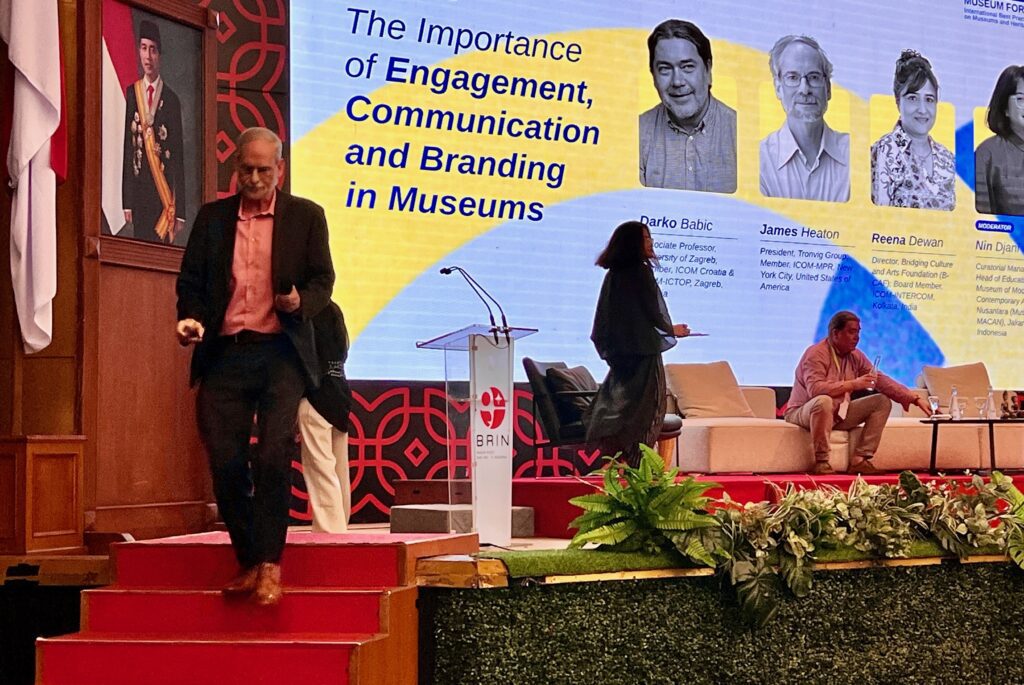
My answer was physical. The presenters had been having trouble hearing questions from the audience and the stage, podium, and layout of the room all created an artificial barricade and separation. I decided to undo some of the hierarchy between the presenters up on stage with microphones, huge screens amplifying their voices on one side; and the audience, pushed back behind a huge cluster of “VIP tables,” inaudible even when they asked a question into a microphone on the other.
Here is where I, the sole American, the democrat, the hopeful agent of the aspiration toward equity, was getting juiced. How could I level the playing field a bit? (This phrase, by the way, is another culturally specific American metaphor. Almost all my metaphors, so easy and useful in my own cultural context, were muted here. Instead of being useful shorthand phrases, they became clutter that interfere with communication.)
How can we learn what is most useful? How can we do that if we are just up here on stage literally talking down to the audience?
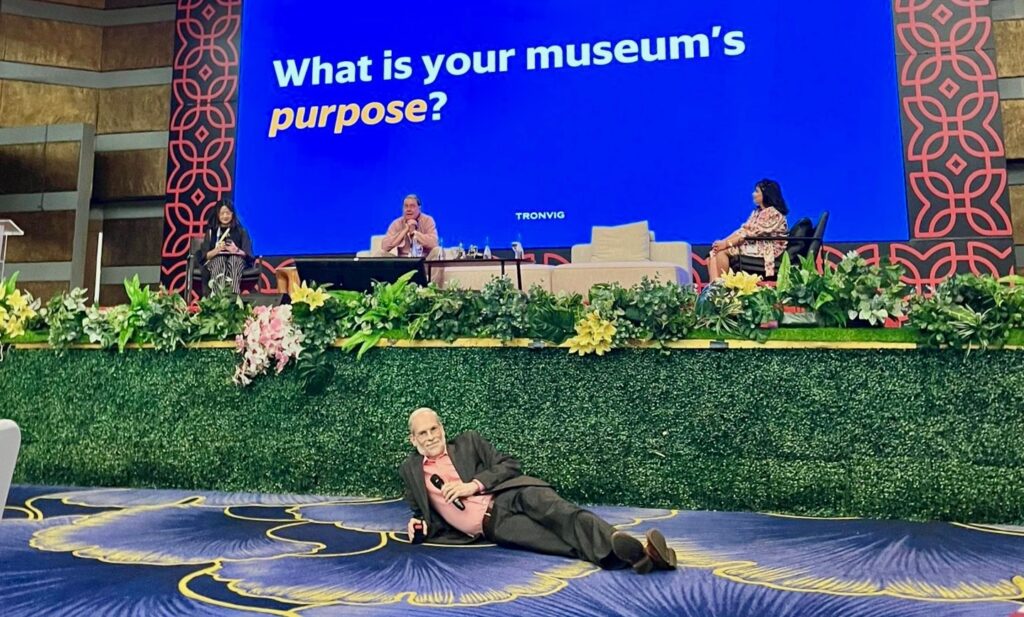
Walking off the stage and lying down on the floor was all I could think of. It removed me from my elevated position above the heads to below the feet of the audience. It woke people up and by making a fool of myself, removed my professional dignity and made me approachable. The presentation was a version of my usual, but my stunt had the hoped-for effect, which was both immediate and lasting. Many young professionals came up to me immediately after and in the hours following the presentation and they continued to do so throughout the following day.
Subsequent speakers made reference to my talk, and the final group of presenters all came off the stage and sat on the same level as the audience for the conference wrap-up. Some of the separation was removed just enough that those in the audience began to feel more empowered. I felt some personal pride in the observation that some of the young professionals from the audience came up onto the stage for the final group photographs as a signal of their equality and inclusion.
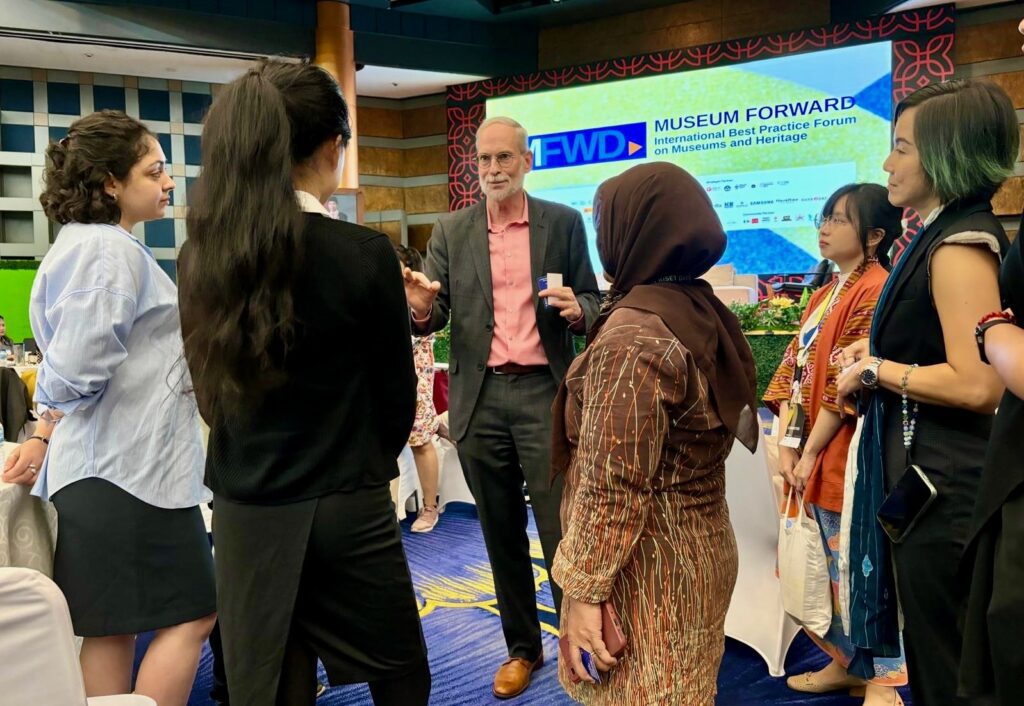
We had made a small step toward being one cohort, a cohort of museum lovers who all have a contribution to make and who each have a role to play in the grand and difficult project of preserving and communicating human culture, history, science, and the arts.
I am deeply grateful to ICOM and all the organizers of this conference for giving me the opportunity to be part of it. If they will have me, I’ll do it again in a heartbeat.
*Officially the conference was Museum Forward, International Best Practice Forum on Museums and Heritage hosted by EUNIC (European Union National Institutes for Culture) Indonesia and sponsored by ICOM (International Council of Museums) and contributed to by three of ICOM’s committees, ICTOP, INTERCOM, and MPR. I was presenting on behalf of MPR—now called COMMS, since it is the PR and Marketing committee for ICOM. The conference was sponsored by ICOM Indonesia.
Photos courtesy of author


Hello James,
I just finished reading about your experience at Museum Forward in Jakarta, and I’m very moved by your remarkable approach and the humanity you brought to such a unique setting. Your decision to step off the stage and literally “level the playing field”—a phrase I first heard as a 27-year-old immigrant and which holds deep personal significance for me—was bold, empathetic, and a true testament to your character.
It so beautifully reflects your commitment to inclusivity and genuine connection. I imagine you must feel proud of the impact you made, and I just wanted to take a moment to acknowledge and appreciate the positive ripple effect you create in the world. 🙏